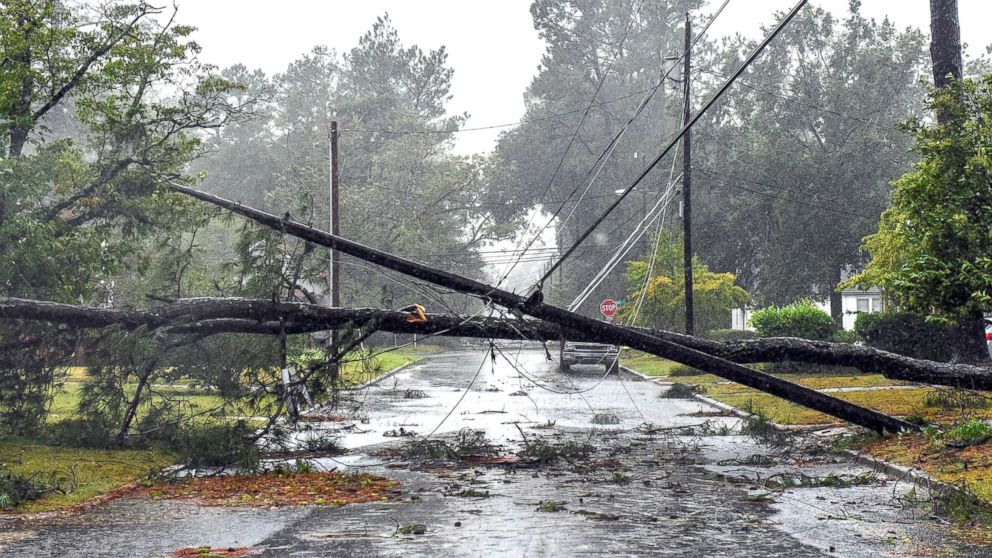
North Carolina Gov. Roy Cooper warned residents to remain vigilant and aware as some of the most detrimental impacts of Florence, which is now a tropical storm, are yet to come.
“We just don’t want people to think this thing is over because it’s not,” Cooper said Saturday of Florence, which was a Category 1 hurricane when it made landfall near Wrightsville Beach on Friday morning.
“We’re going to see areas of flooding that have not flooded before,” he said, adding “I have a real concern about that.”
Heavy rain is expected to continue in North and South Carolina through the weekend and over the next few days, which bring additional water to already-soaked states as well as additional threats like possible landslides in the more mountainous inland parts of the state and electrocution threats with downed power lines.
Cooper said that the storm, which is particularly slow-moving and is hovering over the Carolinas, “will eventually leave our state,” but he called on residents to be resilient until then.
“This one is sure testing us, but now is the time for us to persevere. I have never known North Carolinians to quit in the face of a challenge, and we’re not about to start,” Cooper said.
The rain and flooding expected Saturday could double the 10 to 20 inches that have fallen so far. Neighboring South Carolina was bracing overnight for the brutal wallop of widespread flash flooding, mad, whipping wind and relentless rainfall that crept across the border into the eastern half of the state before dawn.
Florence, which weakened from a Category 1 hurricane when it made landfall early Friday morning to a tropical storm, is expected by Saturday evening to be downgraded to a tropical depression — but the torrential rain shows no signs of letting up anytime soon.
Seven people were reported dead in the storm, including a mother and her baby killed in Wilmington, North Carolina, by a falling tree. Officials in Carteret County, North Carolina, announced on Saturday morning that two people had died on Harkers Island.
There are still more than 990,000 people without power in North and South Carolina combined early Saturday.
Jeff Byard, the FEMA associate administrator for response and recovery, warned Saturday that the danger is not over.
“There is a lot of rain to come. There’s a lot of rain that’s following,” Byard said at a news conference Saturday morning.
“A lot of rain’s going to fall. It’s gotta go somewhere, and we want to be prepared to respond as quickly as possible,” he said.
NOAA representative Steve Goldstein said the storm will produce “catastrophic flooding” for North Carolina and South Carolina in the coming days.
The White House announced Saturday that President Donald Trump approved a disaster declaration for North Carolina, which makes federal funding available for temporary housing and home repairs among other forms of assistance.
In North Carolina’s Onslow County, county manager David Cotton said that first responders had to make 20 home rescues and there are still 200 to 300 people who require rescues.
“We’re not going to stop until we reach all of these folks and get them to a safe shelter,” Cotton told “Good Morning America” Saturday morning. “Right now we are actively in the process of rescuing those that we can reach and we have a plan to reach the rest.”
He said that “unfortunately” conditions in his county were “deteriorating overnight.”
“We received significant rainfall and that has led to countywide flooding,” Cotton said.
There were 385 people rescued overnight in the town of New Bern and there may be about 100 others still in need of rescue there, according to the city’s public information officer Colleen Roberts.
Catastrophic flooding wreaked havoc on parts of eastern North Carolina, which sustained 2 feet of rain in some areas, and up to 40 inches in other hard-hit spots. Newport, North Carolina, reported 23.75 inches of rainfall by 5 a.m. Saturday. Hoffman, North Carolina, had seen 19.96 inches and Conway, South Carolina, had seen 8.68 inches — with two days of rainfall to come.
Forecasters are anticipating landslides near the Appalachians and near-record river flooding.
Flooding there is so heavy that rescue operations had to be suspended early Saturday morning until daylight. Meanwhile, Florence crept across the border into South Carolina overnight, with tropical storm force winds still extending 175 miles from the center.
Just south and west of Carteret, new flash flood emergencies were issued in bordering Onslow and Duplin counties around 3:30 a.m. The latest forecasts indicate that rainfall totals could reach 40 inches in southeast North Carolina and northeast South Carolina.
Norman Bryson, the director of Emergency Services in Onslow County, said as many as 300 people may require rescue services on Saturday as floodwaters continued to rise.
Flooding is anticipated in Charlotte, North Carolina, more than 200 miles inland, as well as Fayetteville and Columbia.
Storm surges could reach 11 feet Saturday along coastal areas, particularly between Cape Fear and Cape Hatteras.
By late Friday evening, tropical storm force winds reaching 85 mph were slamming the coast of both states.
An additional six to 10 inches of rain were expected to shower South Carolina from its eastern shore to locations 75 to 100 miles inland.
President Donald Trump declared a state of emergency in South Carolina ahead of the storm.





